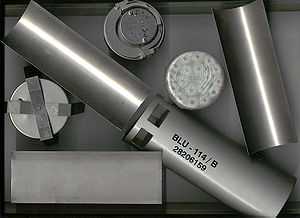BLU-114/B "Soft-Bomb"
| BLU-114/B "Soft-Bomb" | |
|---|---|
| Type | "soft bomb" Multi Sub-Munition |
| Place of origin | United States |
| Service history | |
| In service | 1999–present |
| Used by | NATO |
| Wars | Iraq War , Serbia |
| Production history | |
| Designer | Classified |
| Unit cost | Classified |
| Number built | Unknown , Classified |
| Variants | Classified |
| Specifications | |
| Weight | Classified |
| Length | Classified |
|
| |
| Maximum firing range | Classified |
| Warhead | Unknown Classified |
| Blast yield | Classified |
|
| |
| Wingspan | Unknown |
The BLU-114/B is a special-purpose munition for attacking electrical power infrastructure. Although very little is known about this highly classified weapon, reportedly it functions by dispensing a number of submunitions which in turn disperse large numbers of chemically treated graphite filaments which short-circuit electrical power distribution equipment such as transformers and substations. The weapon is sometimes referred to as a "soft bomb" since its effects are largely confined to the targeted electrical power facility, with minimal risk of collateral damage.
History and usage
This previously undisclosed weapon, carried by the F-117 Nighthawk, was used for the first time on 2 May 1999 as part of Operation Allied Force strikes against Serbia. Following these attacks lights went out over 70 per cent of the country. The munition was subsequently used on the night of 7 May 1999 to counter Serbian efforts to restore damage caused by the initial attack.
Similar in concept to the Kit-2 Tomahawk sea-launched cruise missile warhead used in the opening days of the Gulf War, few details of either weapons can be established on an unclassified basis. The missiles, packed with bomblets filled with small spools of carbon-fibre wire, deprived Iraq of 85% of its generating capacity. During the Gulf War, Iraq responded to the use of this type of munition by disconnecting electrical power grid circuit breakers. Attacks on Iraqi power facilities shut down their effective operation and eventually collapsed the national power grid. Coalition planners in the theater initially directed that the switching system be targeted, rather than the generator halls. For the first three days, the Air Tasking Order explicitly contained specific aimpoints for strikes against electrical production facilities. Subsequently the specific aimpoints were only sporadically included. When wing-level planners lacked specific guidance on which aimpoints to hit at electrical power plants, they sometimes chose to target generator halls, which are among the aimpoints listed in standard targeting manuals.
The BLU-114/B detonates over its target and disperses huge numbers of fine carbon filaments, each far smaller than the crude wire spools used in the Gulf War. The filaments are only a few hundredths of an inch thick and can float in the air like a dense cloud. When the carbon fiber filaments dispensed from the BLU-114/B submunition contact transformers and other high voltage equipment, a short circuit occurs and an electric arc is often created when the current flows through the fiber, which is vaporized. The graphite, which is a conductor of electric current, is probably coated with other materials to enhance these effects. At the spot where the electric field is strongest, a discharge is initiated, and electrons rapidly form an ionised channel that conducts electricity. At this stage current can flow and an arc forms. This causes instantaneous local melting of a certain amount of the material at the surface of the two conductors. If the current involved is strong enough, these arcs can cause injury or start a fire. Fires can also be started by overheated equipment or by conductors that carry too much current. Extremely high-energy arcs can cause an explosion that sends fragmented metal flying in all directions.
Although specific details remain classified, and the Pentagon has explicitly declined to provide any information on this munition, it is probably the case the unit cost of the munition is comparable to that of the Joint Standoff Attack Weapon or the CBU-97/CBU-105 Sensor Fuzed Weapon—in the range of several hundred thousand dollars. The relative simplicity of the concept and the potential to utilize components from other munitions probably allowed relatively low development costs.
The BLU-114/B designation refers to the special purpose submunition, rather than the entire weapon system. It is certainly the case that this submunition is carried to the target area by some dispenser system, of the sort that typically delivers other such submunitions.
-

BLU-114B
-

BLU-114B Museum of Aviation in Belgrade
See also
- AGM-154 Joint Standoff Weapon
- Sensor Fuzed Weapon
- Cluster bomb
- Gulf War
References
- http://www.globalsecurity.org/military/systems/munitions/blu-114.htm
- http://www.fas.org/man/dod-101/sys/dumb/blu-114.htm